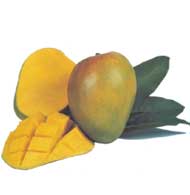|
|
|
|
| |
Mango
( Mangifera indica L. ) is considered to be the
king of fruits. Besides having a delicious taste,
excellent flavour and attractive fragrance, it
is an excellent source of Vitamins A and C. The
tree is hardy in nature and has comparatively
low maintenance costs. Well - maintained orchards
give remunerative returns.
In India, mango occupies 42.6
% of total area under fruits comprising of 0.94
million hectare, with a total production of 8.21
million tonnes. Of the various states, U.P. has
the largest area accounting for nearly 33.2 %
of the total, followed by Bihar (13.5 %) and Andhra
Pradesh (13.4 %). |
 |
Mango fruit is utilised at all stages of its development
both in its immature and mature state. Raw fruits
are used for making chutney, pickles and drinks.
The ripe fruits besides being used for dessert,
are also utilised for preparing several products
like squashes, syrups, nectars, jams and jellies.
Wine can also be made from some mango varieties.
Even the kernal is dried, roasted and eaten. The
mango kernal also contains 8-10 % good quality
fat which can be used for soap and also as a substance
for cocoa in confectionery.
|
|
| There
are about 1000 mango varieties in India. Of those,
however, only about 20 varieties are grown on a
commercial scale |
| |
| Alphonso |
This
is the only type of mango known outside Asia.
It is the main variety produced in the state of
Maharashtra and the best-known export variety.
This is because of its high quality and excellent
keeping capacity. Its range extends over the humid
parts of the West of the Country. The name goes
back to a Frenchman with a Spanish name, one Monsieur
de Alphonso. In the southern state of Karnataka,
the same variety is called Badami, and in Tamil
Nadu, Gundu.
Healthy fruit will keep for
up to three weeks without cooling at moderate
room temperature. The pulp is yellow to orange
in color. It is soft but not mushy, firm and not
at all fibrous, with a distinctive, pleasant flavour.
The tree tends towards alteration in a two-year
bearing cycle. Alphonso mangoes ripen in the middle
of the season, i.e. from early April to the end
of June, in Gujarat and Maharashtra on the west
coast, from mid-May to mid-July in Karnataka,
and from April to May in Tamil Nadu.
This varieties is the leading
commercial variety of Maharashtra state and one
of the best variety of the country. This variety
is known by different names in different regions
viz., Badami, Gundu, Khader, Appus, Happus, Kagdi
Happus. The fruit is medium in size, ovate oblique
in shape and orange yellow in colour. The fruit
quality is excellent. It is a mid season variety.
Keeping quality is good. It has been found good
for canning purposes and is mainly exported to
other countries.
|
| |
| Bangalore
Totapuri |
This
highly productive southern variety is about the
first on the market, and it has a long shelf-life.
However its external appearance leaves something
to be desired and the fruit is of only mediocre
quality. These drawbacks limit its export potential
to countries of the Middle East and Far East.
It is a commercial variety of
South India. The common synonyms of this variety
are Totapuri, kallamai, Thevadiyamuthi, Collector,
Surdersha, Burmodilla, Killi Mukku, Gilli Mukkuu.
The fruit is medium to large oblong with necked
base and colour is golden yellow. Fruit is poor.
Keeping quality is very good. It is a midseason
variety.
|
| |
| Banganpalli |
The
skin is thin, smooth and shining golden yellow.
That’s why in local language the fruit is
known as Benishan, meaning without any blemish
and marks. While the flesh is firm to meaty, fibreless
and yellow, the taste is sweet, the flavour delightful.
It is a commercial variety of
Andhra and Tamil Nadu states. It is also known
as Chapta, Safeda, Baneshan and Chaptai. Fruit
is large in size and obliquely oval in shape.
The colour of the fruit is golden yellow. Fruit
quality is good. Keeping quality is good. It is
a midseason variety and is good for canning.
|
| |
| Dashehari |
This
variety derives its name from the village Dashehari
between Lucknow and Milihabad which is a major
center of mango production. It is a leading commercial
variety of North and one of the best varieties
of our country. Besides a good shelf-life, Dushehari
boasts a particularly high level of vitamin C.
The tree comes into bearing early, producing commercially
viable fruit as early as the fourth year. Against
this must be set the drawbacks of variations in
taste, sharply alternating yields and an unattractive
appearance. This is because the variety is extremely
vulnerable to ‘mango malformation.’
Dushehari has a certain importance in exports
to the Middle East. |
| |
|
|
|
